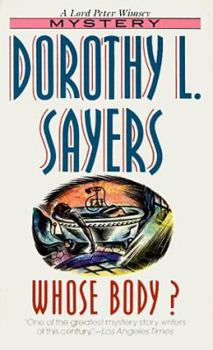Book Overview
The naked body was lying in the tub. Not unusual for a proper bath, but highly irregular for murder--especially with a pair of gold pince-nez deliberately perched before the sightless eyes. What's more, the face appeared to have been shaved after death. In this, his first murder case, Lord Peter untangles the mystery of the corpse in the bath.
Format:Mass Market Paperback
Language:English
ISBN:0061043575
ISBN13:9780061043574
Release Date:July 1995
Publisher:HarperTorch
Length:224 Pages
Weight:0.27 lbs.
Dimensions:0.6" x 4.2" x 6.8"
Related Subjects
British Detectives Cozy Fiction Literature & Fiction Mystery Mystery, Thriller & SuspenseCustomer Reviews
5 ratings
Accept no substitutes: Ian Carmichael is the ONLY person to read Lord Peter.
Published by Thriftbooks.com User , 17 years ago
This is the unabridged audiobook of Lord Peter Wimsey's introduction, "Whose Body". Whatever you do, do NOT purchase any Lord Peter audiobooks unless they are read by Ian Carmichael. He is the perfect Lord Peter, and he reads all of the Lord Peter novels better than anyone else. It's a lot harder to find "Whose Body" than any of the others, especially if you're looking specifically for Ian Carmichael's version. But after listening to David Case and Roe Kendall, I've always returned to Ian Carmichael, no matter how hard it may be to find it.
The Body in the Bathroom
Published by Thriftbooks.com User , 22 years ago
When Lord Peter Wimsey is called in by Her Grace the Dowager Duchess (AKA Mother) to help extricate the timid Mr. Thipps from a case of body in the bathtub he finds himself embroiled in for far more than he has bargained. For one thing, the church architect's excess body, naked except for a Gold pince-nez, appears to be inexplicable. When it turns out that Sir Reuben Levy, an important financier is missing, the police become convinced that the body is that of Levy, and seize Thipps and the maid as the guilty party, despite all evidence to the contrary. Now Wimsey must work quickly with his friend Inspector Parker to solve both crimes and save both Thipps and the leaking church roof.Thus begins Dorothy Sayer's first novel in the Lord Peter Wimsey series. Partly a satire of the British upper class, partly a comedy of manners, and mostly the first of a time honored series of detective novels that very nearly reinvented the British mystery story in the 1920's. Lord Peter is the second son of the current generation of the Dukes of Denver, his rather stuffy brother currently holding the title. Lately recovered from some harrowing war experiences and a badly ended relationship, he has come to be an amateur detective as a way to gain a new focus in life. Wimsey is intelligent, only occasionally serious, and a perfect image of the English gentleman.Accompanying Lord Peter is his most excellent manservant Bunter, who served with him in the war and has become a loyal and true companion. Bunter is the straight man for many of Wimsey's quips and quotes, but has a wry wit of his own, and is probably the first forensic photographer in detective fiction. Lord Peter's other aide in this and ensuing tales is Inspector Parker who is of the same age and equally bright in his own right. A man after my own heart, Parker reads theology for entertainment. While the detection style has much of the same cerebral quality which mark many of Holmes' adventures, Wimsey and his companions are far more accessible than the 'Consulting Detective.'Sayer's has a unique ability to do caricature, creating little gemlike performances for each of the people who parade through her stories. Be they somewhat dull policemen to distinguished surgeons, nobody is unmemorable. The wonderful characters, and Wimsey's own unique charms are very much the reasons that ''Whose Body' and the rest of the tales remain rereadable long after the plot has been completely memorized. Hopefully, you are a reader newly come to the world of Lord Peter and can look forward to the delights of this discovery. Dorothy Sayers is very much in a class by herself, both in terms of her own achievements and because of the history of her most remarkable invention, Lord Peter Death Bredon Wimsey.
Review
Published by Thriftbooks.com User , 23 years ago
With her first book Whose Body? (1923), Dorothy L. Sayers introduced her famous detective Lord Peter Wimsey, or "Sherlock Holmes, disguised as a walking gentleman", and established herself as a mistress of the detective story.Although Lord Peter Wimsey is here perhaps too bright and breezy, he proves to be an entertaining companion to crime, despite his suffering from conscience. He enjoys the detection, "but if it comes to really running down a live person and getting him hanged, or even quodded, poor devil, there don't seem as if there was any excuse for me buttin' in, since I don't have to make my livin' by it. And I feel as if I oughtn't ever to find it amusin'. But I do." The reader, who has no conscience to worry him, enjoys the whole thing without needing to consult their consciences, for the story is bright and amusing, well-written and often very funny, even if somewhat in the Wodehousian vein.Although Lord Peter Wimsey is a vivid but undeveloped character, the rest of the characters are all quite vivid: the Dowager Duchess of Denver is an excellent character, and, by the standards of the day, Sayers seems to have not too much racism / anti-Semitism.Despite all the humour, the serious business of detection is not neglected. Opening with the fine and striking idea of the body in the bathtub-rightly described as an "uncommon good incident for a detective story", and an interesting problem of identity-the trail gets more complicated with the disappearance of Sir Reuben Levy. The murderer's identity is revealed half-way through-a trait that would recur in later Sayers novels, and the pleasure of the second half of the book is in seeing an elaborate, ingenious, and often gory, plot unfold.It is interesting to note that Sayers, an Anglo-Catholic, chose a scientist / atheist as her murderer, a villain who believes that "the knowledge of good and evil is an observed phenomenon, attendant upon a certain condition of the brain cells, which is removable..."-a belief striking at the very core of Christianity, and a belief leading the murderer to the belief that murder is a justifiable action. In this, Sayers resembles Chesterton, and, in particular, "The Wrong Shape". In Lord Peter Wimsey's realisation of the murderer's guilt, Christianity is again apparent, for Wimsey seems to solve the crime through receiving a divine revelation (although the clues are all there-detection from physical clues in the Thorndykean manner): "he remembered-not one thing, not another thing, nor a logical succession of things, but everything-the whole thing, perfect, complete, in all its dimensions as it were and instantaneously; as if he stood outside the world and saw it suspended in infinitely dimensional space. He no longer needed to reason about it, or even to think about it. He knew it."An excellent first attempt at the detective story, and the reader can agree with Wimsey that although "this is only a blinkin' old shillin' shocker ... we're up against a c
The first Lord Peter story, well read.
Published by Thriftbooks.com User , 25 years ago
The reader of this book does beautifully at distinguising the various voices of the characters, making it a joy to listen to. The story is a good puzzle - the first of many excellent Lord Peter mysteries!
Great entry in the first of a most entertaining series
Published by Thriftbooks.com User , 25 years ago
I count myself as a devoted fan of Lord Peter Wimsey. The first book I read in the series was "Unnatural Death" which I would highly recommend, but only after reading "Whose Body?" first. It is a most entertaining introduction to Lord Peter, the impeccable Bunter, his policeman friend Parker, and Peter's family, including the spirited and hilarious Dowager Duchess of Denver and Peter's elder brother, the present Duke, who is disgruntled at his younger brother's being mixed up in police business (a trait, he will however find very useful in "Clouds of Witness"). The mystery itself is genuinely gripping and although Sayers deliberately makes the reader aware of the identity of the killer halfway through the book (a similar tactic she used in "Unnatural Death"), the real pleasure lies in the carefully orchestrated revealing of further details, and the way Lord Peter's hypothesis is gradually confirmed in every respect. No blood and gore and car chases here, just a great intellectual exercise and a fascinating novel. Highly recommended for readers who love the period!
Whose Body? Mentions in Our Blog

10 Books Turning 100 This Year
Published by Ashly Moore Sheldon • January 15, 2023
It's interesting to look back at pop culture that withstands the test of time. In the past weeks, we've reflected on some of the notable books and movies that came out five decades ago. Now we turn our attention to the books turning 100 this year. Here are ten memorable books from 1923.






